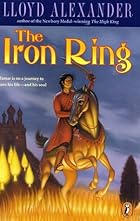 In the middle of the night, young king Tamar is awoken by a parade of elephants and courtiers. The cause of the discourteous commotion is King Jaya, a monarch of a faraway kingdom, who is passing through and demands lodging. Jaya promptly challenges Tamar to a game of aksha (a dice game), with increasingly high stakes. Caught up in a rash of winnings, Tamar feverishly bets his life against Jaya's - and loses. Triumphant, Jaya claims his prize... and vanishes. No one but Tamar seems to remember the rude king's visit, and there is no proof for it - except for the iron ring around Tamar's finger, symbolizing, supposedly, Jaya's hold on Tamar's life.
In the middle of the night, young king Tamar is awoken by a parade of elephants and courtiers. The cause of the discourteous commotion is King Jaya, a monarch of a faraway kingdom, who is passing through and demands lodging. Jaya promptly challenges Tamar to a game of aksha (a dice game), with increasingly high stakes. Caught up in a rash of winnings, Tamar feverishly bets his life against Jaya's - and loses. Triumphant, Jaya claims his prize... and vanishes. No one but Tamar seems to remember the rude king's visit, and there is no proof for it - except for the iron ring around Tamar's finger, symbolizing, supposedly, Jaya's hold on Tamar's life.As there is still a chance that Jaya was not a dream, and therefore is still owed a life-debt by Tamar, Tamar decides to journey to Jaya's kingdom. Taking his loyal mentor and brahmana Rajaswami with him, Tamar sets out to make good on his dharma, or honor.
As my first non-Prydain Lloyd novel, I had high-hopes for The Iron Ring. Admittedly, I shouldn't compare, but it is hard to be unbiased with the other books of an author who wrote such a classic series.
Basically, The Iron Ring is a not-so-epic epic. Using something of a formula in fantasy, the protagonist goes on a quest with his trusty mentor, meets both comedic and mysterious sidekicks, and his ladylove, along with, of course, a minor villain. All while the threat that the iron ring symbolizes hangs over Tamar's head.
The first part of the book was amusing at times, tiresome at others. Very little was unexpected. Mirri, especially, I found annoying, as a typical 'I am woman, hear me roar at you bothersome men' heroine. Tamar and the other characters were flat and unappealing.
About three-fourths of the way through the book, however, things picked up. Action was more interesting. Tamar was at rock bottom; this character was dead; is another dead as well? Or is there a plan? These chapters rekindled my dying interesting. But the flames didn't last long, and the end fizzled in what seemed a cop-out.
There was also a definite lack of the title character - the iron ring. In a story one would think was about Tamar's determination to get to the bottom of King Jaya's odd appearance and disappearance, he thinks very little about his bondage. During the first part of the book, little 'mini-adventures' distract him; the second part is filled with fighting the minor villain. One starts to wonder what the goal of the story is, after a while.
On a more positive note, The Iron Ring is based on Indian and Hindu mythology and psychology, with plenty of talking animals (more so than humans) and dharma-defending. At times this was confusing - are they not surprised that animals talk? I thought this character just voiced doubt about the forest's talking beasts. But the information on a mythology rarely studied was interesting, and I can see Lloyd's attraction to it.
In short, The Iron Ring is a typical mini-epic. Short on originality, though full of potential inspiration. Readers fond of Lord of the Rings-esque, questing novels will be interested; to others, I would hesitate to recommend it.

No comments:
Post a Comment